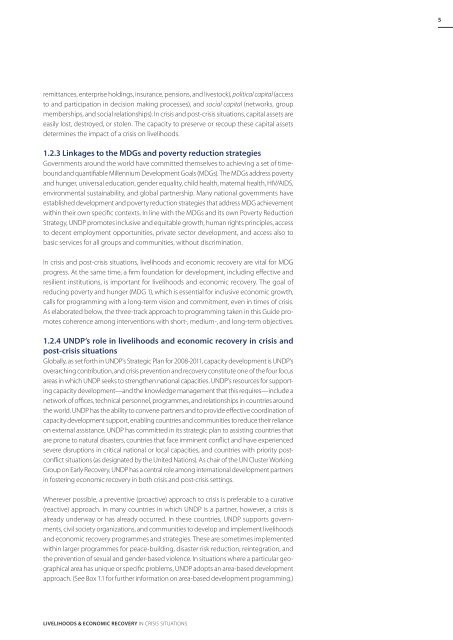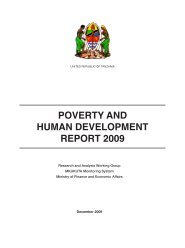Download PDF (4.08 MB) - ReliefWeb
Download PDF (4.08 MB) - ReliefWeb
Download PDF (4.08 MB) - ReliefWeb
Create successful ePaper yourself
Turn your PDF publications into a flip-book with our unique Google optimized e-Paper software.
5<br />
remittances, enterprise holdings, insurance, pensions, and livestock), political capital (access<br />
to and participation in decision making processes), and social capital (networks, group<br />
memberships, and social relationships). In crisis and post-crisis situations, capital assets are<br />
easily lost, destroyed, or stolen. The capacity to preserve or recoup these capital assets<br />
determines the impact of a crisis on livelihoods.<br />
1.2.3 Linkages to the MDGs and poverty reduction strategies<br />
Governments around the world have committed themselves to achieving a set of timebound<br />
and quantifiable Millennium Development Goals (MDGs). The MDGs address poverty<br />
and hunger, universal education, gender equality, child health, maternal health, HIV/AIDS,<br />
environmental sustainability, and global partnership. Many national governments have<br />
established development and poverty reduction strategies that address MDG achievement<br />
within their own specific contexts. In line with the MDGs and its own Poverty Reduction<br />
Strategy, UNDP promotes inclusive and equitable growth, human rights principles, access<br />
to decent employment opportunities, private sector development, and access also to<br />
basic services for all groups and communities, without discrimination.<br />
In crisis and post-crisis situations, livelihoods and economic recovery are vital for MDG<br />
progress. At the same time, a firm foundation for development, including effective and<br />
resilient institutions, is important for livelihoods and economic recovery. The goal of<br />
reducing poverty and hunger (MDG 1), which is essential for inclusive economic growth,<br />
calls for programming with a long-term vision and commitment, even in times of crisis.<br />
As elaborated below, the three-track approach to programming taken in this Guide promotes<br />
coherence among interventions with short-, medium-, and long-term objectives.<br />
1.2.4 UNDP’s role in livelihoods and economic recovery in crisis and<br />
post-crisis situations<br />
Globally, as set forth in UNDP’s Strategic Plan for 2008-2011, capacity development is UNDP’s<br />
overarching contribution, and crisis prevention and recovery constitute one of the four focus<br />
areas in which UNDP seeks to strengthen national capacities. UNDP’s resources for supporting<br />
capacity development—and the knowledge management that this requires—include a<br />
network of offices, technical personnel, programmes, and relationships in countries around<br />
the world. UNDP has the ability to convene partners and to provide effective coordination of<br />
capacity development support, enabling countries and communities to reduce their reliance<br />
on external assistance. UNDP has committed in its strategic plan to assisting countries that<br />
are prone to natural disasters, countries that face imminent conflict and have experienced<br />
severe disruptions in critical national or local capacities, and countries with priority postconflict<br />
situations (as designated by the United Nations). As chair of the UN Cluster Working<br />
Group on Early Recovery, UNDP has a central role among international development partners<br />
in fostering economic recovery in both crisis and post-crisis settings.<br />
Wherever possible, a preventive (proactive) approach to crisis is preferable to a curative<br />
(reactive) approach. In many countries in which UNDP is a partner, however, a crisis is<br />
already underway or has already occurred. In these countries, UNDP supports governments,<br />
civil society organizations, and communities to develop and implement livelihoods<br />
and economic recovery programmes and strategies. These are sometimes implemented<br />
within larger programmes for peace-building, disaster risk reduction, reintegration, and<br />
the prevention of sexual and gender-based violence. In situations where a particular geographical<br />
area has unique or specific problems, UNDP adopts an area-based development<br />
approach. (See Box 1.1 for further information on area-based development programming.)<br />
Livelihoods & Economic Recovery in Crisis Situations





